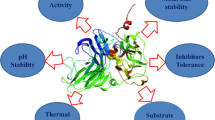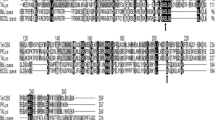Abstract
An extracellular lipase, which is produced by theNeurospora sp. TT-241 strain, grown on wheat bran at 30°C for 4 d, was purified 370-fold with an overall yield of 16%. The molecular weight was determined to be 55 kDa by sodium dodecyl sulfate-polyacrylamide gel electrophoresis. The optimal pH at 30°C and optimal temperature at pH 6.5 were 7 and 45°C, respectively. The lipase was stable in the pH range of 5 to 8, and it was temperature-sensitive. It was active on a wide range of natural substrates of either vegetable or animal origins and towardp-nitrophenyl esters, greatly favoring those containing C4 acyl groups. It cleaved all of the ester bonds of triolein; however, the 1- or 3-ester bond was the preferred target. A complete inhibition by diisopropyl fluorophosphate suggested the presence of a serine residue at the active site. Partial inhibition was shown by either Hg2+ or chloramine T. Enzyme activity persisted in nonionic surfactants, a water-miscible solvent (dimethylsulfoxide), and a water-immiscible solvent (hexane).
Similar content being viewed by others
References
Macrae, A.R., Lipase-Catalyzed Interesterification of Oils and Fats,J. Am. Oil Chem. Soc. 60:291–294 (1981).
Tanaka, T., E. Ono, M. Ishihara, S. Yamanaka, and K. Takenami, Enzymatic Acyl Exchange of Triglyceride inn-Hexane,Agric. Biol. Chem. 45:2387–2389 (1981).
Okumura, S., M. Iwai, and Y. Tsujisaka, Synthesis of Various Kinds of Esters by Four Microbial Lipases,Biochim. Biophys. Acta 575:156–165 (1979).
Nakano, H., S. Kitahata, Y. Tominaga, and S. Takenishi, Esterification of Glycosides with Glycerol and Trimethylopropane Moieties byCandida cyclindracea Lipase,Agric. Biol. Chem. 55:2083–2089 (1991).
Wang, C.H., Enzymatic Catalysis in Organic Synthesis,Science 244:1145–1152 (1989).
Zaks, A., and A.M. Klibanov, Enzymatic Catalysis in Organic Media at 100°C,224:1249–1251 (1984).
Zaks, A., and A.M. Klibanov, Enzyme-Catalyzed Processes in Organic Solvents,Proc. Natl. Acad. Sci. USA 82:3192–3196 (1985).
Bjokling, F., S.E. Godtfredsen, and O. Kirk, the Future Impact of Industrial Lipases,Trends Biotech. 9:360–363 (1991).
Abrige, M.V., P.R. Freund, S.C. Silver, and J.T. Zelko, Novel Lipase for Cheddar Cheese Flavor Development,Food Technol. 40:91–98 (1986).
Fregapane, G., D.B. Sarney, and E.N. Vulfson, Enzymic Solvent-Free Synthesis of Sugar Acetal Fatty Acid Esters,Enzyme Microb. Technol. 13:796–800 (1991).
Santaniello, E., P. Ferraboschi, and P. Grisenti, Lipase-Catalyzed Transesterification in Organic Solvents: Applications to the Preparation of Enantiomerically Pure Compounds,15:367–382 (1993).
Andree, H., W.-R. Muller, and R.D. Schmid, Lipases as Detergent Components,J. Appl. Biochem. 2:218–229 (1980).
Chartrain, M., L. Katz, C. Marcin, M. Thien, S. Smith, E. Fisher, K. Goklen, P. Salmon, T. Brix, K. Price, and R. Greasham, Purification and Characterization of a Novel Bioconverting Lipase fromPseudomonas aeruginosa MB 5001,Enzyme Microb. Technol. 15:575–580 (1993).
Haas, M.J., D.J. Cichowicz, and D.G. Bailey, Purification and Characterization of an Extracellular Lipase from the FungusRhizopus delamer, Lipids 27:571–576 (1992).
Baillargeon, M.W., and S.G. McCarthy,Geotrichum candidum NRRL Y-553 Lipase: Purification, Characterization and Fatty Acid Specificity,26:831–836 (1991).
Ohnishi, K., Y. Yoshida, and J. Sekiguchi, Lipase Production ofAspergillus oryzae, J. Fermet. Bioeng. 77:490–495 (1994).
Mase, T., Y. Matsumiya, and A. Matsuura, Purification and Characterization ofPenicillum roqueforti IAM 7268 Lipase,Biosci. Biotech. Biochem. 59:329–330 (1995).
Mozaffar, Z., and J.D. Weete, Purification and Properties of an Extracallular Lipase fromPythium ultimum, Lipids 28:377–382 (1993).
Shimada, Y., C. Koga, A. Sugihara, T. Nagao, N. Takada, S. Tsunasawa, and Y. Tominaga, Purification and Characterization of a Novel Solvent-Tolerant Lipase fromFusarium heterosporum, J. Fermet. Bioeng.,75:349–352 (1993).
Bradford, M.M., A Rapid and Sensitive Methods for the Quantitation of Microgram Quantities of Protein Utilizing the Principle of Protein-Dye Binding,Anal. Biochem. 72:248–254 (1976).
Winkler, U.K., and M. Stuckmann Glycogen, Hyauronate and Some Other Polysaccharides Greatly Enhance the Formation of Exolipase bySerratia macrescences, J. Bacteriol. 138:663–670 (1979).
Kwon, D.Y., and J.S. Rhee, A Simple and Rapid Colorimetric Method for Determination of Free Fatty Acids for Lipase Assay,J. Am. Oil Chem. Soc. 63:89–92 (1986).
Laemmli, U.K., Cleavage of Structure Protein During the Assembly of the Head of Bacteriophage T4,Nature (London) 227:680–685 (1970).
Bollag, D.M., and S.J. Edelsstein, Isoelectric Focusing and Two-Dimensional Gel Electrophoresis, inProtein Methods, Wiley-Liss Press, New York, 1991, pp. 161–180.
Sugihara, A., Y. Shimada, and Y. Tomonaga, A NovelGeotrichum candidum Lipase with Some Preference for the 2-Position on a Triglyceride Molecule,Appl. Microbiol. Biotechnol. 35:738–740 (1991).
Druet, D., N.E. Abbadi, and L.-C. Comeau, Purification and Characterization of the Extracellular and Cell-Bound Lipase from aPenicillium cyclopium Variety,37:745–749 (1992).
Yamamoto, K., and N. Furiwara, Purification and Some Properties of a Castor-Oil-Hydrolyzing Lipase fromPseudomonas sp.,Agric. Biol. Chem. 52:3015–3021 (1988).
Kundu, M., J. Basu, M. Guchhait, and P. Chakrabarti, Isolation and Characterization of an Extracellular Lipase from the Conidia ofNeurospora crassa, J. Gen. Microbiol., 133:149–153 (1987).
Author information
Authors and Affiliations
About this article
Cite this article
Lin, Sf., Lee, JC. & Chiou, CM. Purification and characterization of a lipase fromNeurospora sp. TT-241. J Am Oil Chem Soc 73, 739–745 (1996). https://doi.org/10.1007/BF02517950
Received:
Accepted:
Issue Date:
DOI: https://doi.org/10.1007/BF02517950




